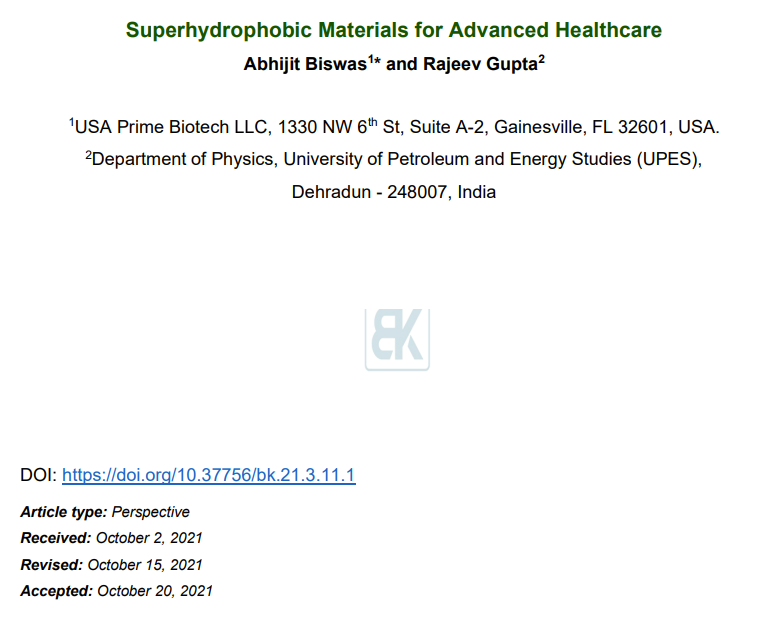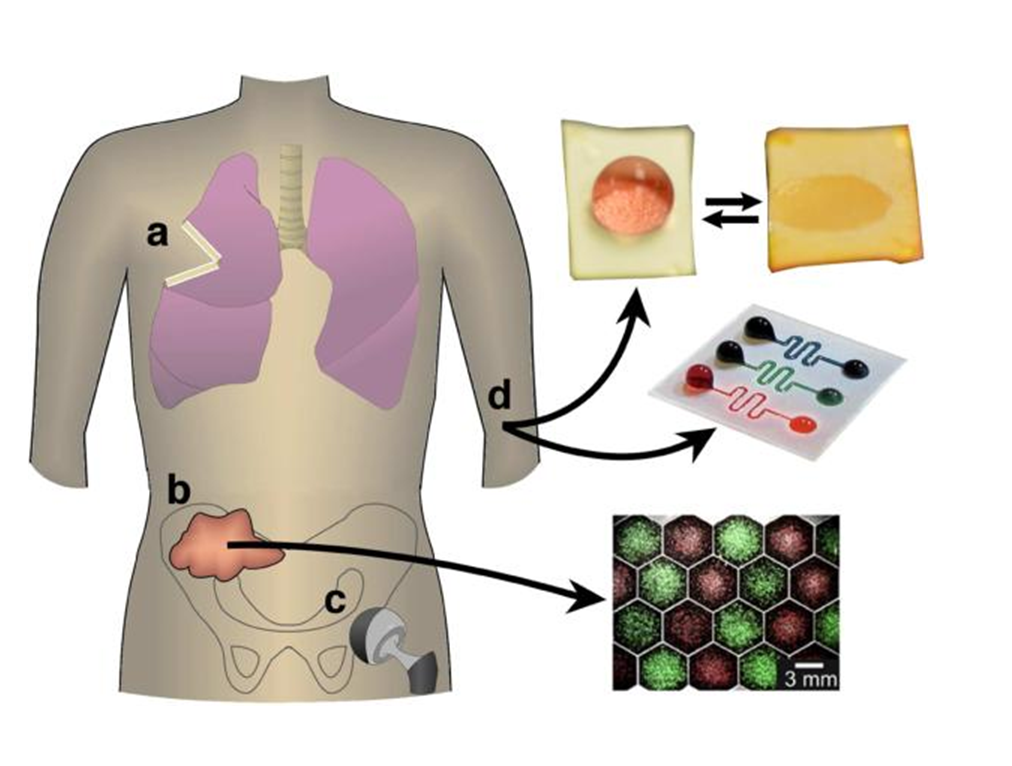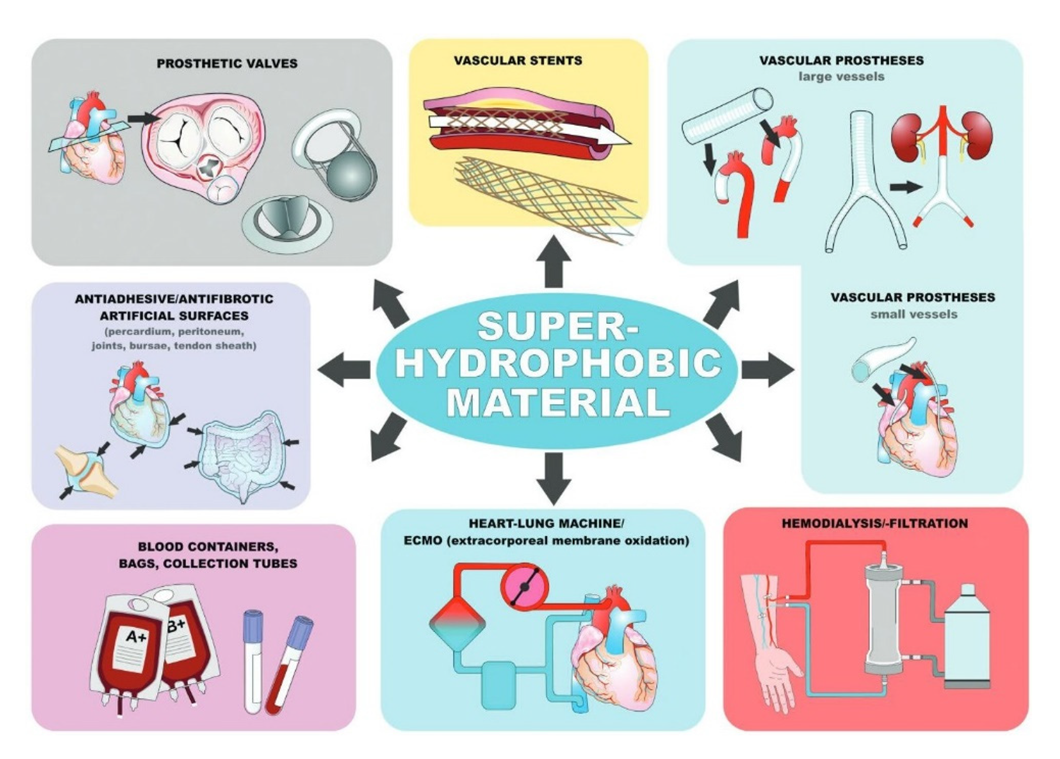Perspective

Abstract
Superhydrophobic surfaces are known for a vast array of industrial applications. These surfaces and coatings are now increasingly finding applications in the biomedical sector. Such applications include substrates to control protein adsorption, cellular interaction, and bacterial growth and blood repellent actions. Superhydrophobic surfaces can be leveraged to develop advanced biotechnology platforms for drug delivery devices and also for diagnostic tools. In this short perspective, we have presented some of the most relevant recent research developments that have been reported on superhydrophobic biomedical surfaces and coatings and that have been considered significant in advanced healthcare.
Keywords: Superhydrophobic; self-cleaning; medical implants; blood repellence; antimicrobial
Received: October 2, 2021
Revised manuscript: October 15, 2021
Accepted: October 20, 2021
*E-mail: abbtf@yahoo.com
1. Introduction
It is known that when surfaces of superhydrophobic materials come in contact with water, these surfaces maintain air at the solid-liquid interface and exhibit high contact angles exceeding 150°. The resulting high contact angle is due to the composite solid-air surface that is formed under a water droplet [1, 2]. Materials that are used to fabricate superhydrophobic surfaces have low surface energy. The low surface energy arises due to non-polar chemistries of CH2/CH3 or CF2/CF3 organic groups present in the materials. In addition, other features include close packed and stable atomic structures that result in high contact angles even without material surface roughening. Over the years, these favorable surface properties have prompted researchers to fabricate synthetic superhydrophobic surfaces with tailored surface chemistry and morphology in order to maintain air at the material-water interface for various applications including biomedical technologies [3].
Superhydrophobic surfaces have not only been considered to protect plants and animals, but they are also considered pivotal to safeguard human life and health. With respect to biomedical applications, superhydrophobic coatings have been considered especially due to their unique non-wetting properties and self–cleaning, corrosion-resistant, and resistant to bioadhesion, to name a few [4-6]. In a number of studies, it has been shown that superhydrophobic surfaces interact with tissues, cells, biological fluid, and biological molecules that can be leveraged for applications in healthcare. To this end, several biological applications of superhydrophobic surfaces have been demonstrated that include but not limited to medical devices and artificial blood vessels to improve their anticoagulation and blood compatibility. Another clinically-important area is superhydrophobic antibacterial coating. These coatings can be employed to inhibit the growth of bacteria on the surface or directly kill bacteria by surface modification. To this end, researchers have employed superhydrophobic and antibacterial coatings on the surfaces of medical devices and biological implants [7, 8]. For example, surgical instruments in the clinic can get contaminated by blood adhesion and bacterial adherence during surgery. These contaminated instruments can subsequently cause bacterial infections in patients. Blood contacting medical devices that are treated with superhydrophobic antibacterial coatings can overcome these challenges by preventing blood adhesion and bacterial adherence, thus, safeguarding the life and health of patients [9-14]. Figure 1 shows various biomedical applications employing superhydrophobic surfaces [3].
In this short perspective, we have presented some exciting applications of superhydrophobic materials in modern healthcare.

Figure 1: Superhydrophobic materials for a number of medical applications that include (a) control of the local release of drugs after tumor resection (b) patterned cell growth that can be applied to study cellular communication (c) reduced bacterial adhesion on implants such as hip replacements can be achieved and (d) stabilization of droplets to drive flow using microfluidics and diagnostic assays [Source: Biomaterials (2016)].
2. Antimicrobial and Self-Cleaning Surfaces in Modern Healthcare
In modern healthcare, it is critical to reduce morbidity and mortality that happen as a consequence of bacterial infections. To this end, antimicrobial and self-cleaning superhydrophobic materials are considered vital that can meet the requirements of medical devices and public health products for practical applications. It is believed that such antimicrobial coatings can induce surface functionality while maintaining the overall performance of the material. Therefore, the development of superhydrophobic coatings with antimicrobial and self-cleaning properties is currently a very active field of research in the healthcare industry that needs antimicrobial protection to medical devices and biological implants. Such strategies are believed helpful to counter or prevent growth of certain microorganisms that can survive on medical devices for more than 90 days. This can subsequently result in maintaining significant antimicrobial and antibacterial effects on pathogenic microorganisms for a longer period of time for medical grade antimicrobial materials. Additionally, studies have shown that such superhydrophobic antimicrobial material coatings can also impart excellent biocompatibility for medical bio-implants [15-17].
3. Need for Blood-Repellent Surfaces for Medical Devices
Medical devices that function in contact with blood are very common in today’s clinical medicine and biotechnology. The use of implantable medical devices is considered a very important part of modern healthcare. There are several such devices that include vascular grafts, coronary stents, heart valves, catheters, hemodialysers, heart-lung bypass systems, just to name few [18]. However, there are challenges for the proper functioning of these devices. For example, when medical devices come into contact with blood, the interaction could result in undesired activation of blood cells including platelets and monocyte/macrophages of the immune system. This also includes some other bioactive blood components, for example the complement and coagulation cascades. These reactions generally lead to serious medical conditions including formation of blood clots or thrombi, inflammation, and also it could activate the immune system. To overcome these medical issues, there have been several advances and breakthroughs that have focused on developing new line of treatment. These efforts were primarily aimed to overcome the various levels of blood incompatibility of surfaces. However, some issues still remain to be addressed that include the tendency to adsorb proteins that triggers both enzyme cascade and blood-cell activations. Hence, there is an urgent need to develop materials that are thrombus-free indefinitely and in all situations including extracorporeally, in the venous circulation and also in the arterial circulation [19, 20].
Further, it has been observed that the biological environment in the body is conducive to the colonization of microorganisms on the surface that results in the formation of biofilms on the surface of catheters. This happens as a result of need for the devices for short-term or long-term existence in the body and frequent contact with the human body. This may lead to serious infection of medical materials that are implanted in the body that may cause thrombosis [21].

Figure 2: Schematic conceptual depiction of employing superhydrophobic surfaces as blood-repellent coatings for advanced medical devices [Source: Adv. Mater. (2018)].
As we described before, biocompatibility should be considered along with antibacterial effects for all medical human implants. Superhydrophobic surfaces are very promising to address the issues related to blood contacts because such surfaces are known to be antibacterial as well as biocompatible properties that can be leveraged for biomedical implant applications. A major advantage of employing a superhydrophobic surface coating is that it can prevent the rejection of biomedical implants in the human body. To this end, in a study, researchers demonstrated a superhydrophobic material for dental implants. It was fabricated using commercial stainless steel, stearic acid, and chemical etching compounds. In another study, superhydrophobic titanium was fabricated by the anodizing method. Titanium structures were combined with fluorine coatings in valves and stents that resulted in reducing platelet adhesion and thrombosis [20, 22, 23]. Figure 2 shows various applications of superhydrophobic surfaces in preventing blood adhesion [20].
4. Concluding Remarks
There is a growing need for medical implants in today’s healthcare to combat complex diseases and medical conditions. To this end, recent research activities have shown huge promise of employing superhydrophic materials and coatings for medical devices to mitigate the challenges of blood contact induced issues including serious infections and pathogens, to name a few. This field is still evolving and we anticipate more research activities to develop biocompatible, self-cleaning superhydrophobic materials in the future for all next generation applications of medical devices and implants.
References
[1] Cassie ABD., Baxter S., Wettability of porous surfaces, Trans. Faraday Soc, 1944, 40:546–551, DOI: https://doi.org/10.1039/TF9444000546.
[2] Wenzel RN., Resistance of solid surfaces to wetting by water, J. Ind. Eng. Chem, 1936, 28:988–994, DOI: https://doi.org/10.1021/ie50320a024.
[3] Falde EJ., Yohe ST., Colson YL., Grinstaff MW., Superhydrophobic materials for biomedical applications, Biomaterials, 2016, 104:87-103,
DOI: https://doi.org/10.1016/j.biomaterials.2016.06.050.
[4] Latthe S.S., Sutar R.S., Kodag V.S., Bhosale A.K., Kumar A.M., Kumar Sadasivuni K., Xing R., Liu S., Self-cleaning superhydrophobic coatings: Potential industrial applications, Prog. Org. Coat., 2019, 128:52–58, DOI: https://doi.org/10.1016/j.porgcoat.2018.12.008.
[5] Sun Y., Guo Z., Recent advances of bioinspired functional materials with specific wettability: From nature and beyond nature. Nanoscale Horiz., 2019, 4:52–76, DOI: https://doi.org/10.1039/C8NH00223A.
[6] Esmeryan K.D., Avramova I.A., Castano C.E., Ivanova I.A., Mohammadi R., Radeva E.I., Stoyanova D.S., Vladkova T.G., Early stage anti-bioadhesion behavior of superhydrophobic soot based coatings towards pseudomonas putida. Mater. Des., 2018, 160:395–404, DOI: https://doi.org/10.1016/j.matdes.2018.09.037.
[7] Jiang J.Y., Xu J.L., Liu Z.H., Deng L., Sun B., Liu S.D., Wang L., Liu H.Y., Preparation, corrosion resistance and hemocompatibility of the superhydrophobic TiO2 coatings on biomedical Ti-6Al-4V Alloys, Appl. Surf. Sci., 2015, 347:591–595, DOI: https://doi.org/10.1016/j.apsusc.2015.04.075.
[8] Ellinas Kosmas, Kefallinou Dionysia, Stamatakis Kostas, Gogolides Evangelos and Tserepi Angeliki, Is There a Threshold in the Antibacterial Action of Superhydrophobic Surfaces? ACS Appl. Mater. Interfaces, 2017, 9, 45:39781–39789, DOI: https://doi.org/10.1021/acsami.7b11402.
[9] Tesler, A.B., Kim, P., Kolle, S., Howell, C., Ahanotu, O., Aizenberg, J., Extremely durable biofouling-resistant metallic surfaces based on electrodeposited nanoporous tungstite films on steel. Nat. Commun., 2015, 6:8649, DOI: https://doi.org/10.1038/ncomms9649.
[10] Yao, X., Song, Y., Jiang, L., Applications of bio-inspired special wettable surfaces, Adv. Mater., 2011, 23:719–734, DOI: https://doi.org/10.1002/adma.201002689.
[11] Luong-Van E, Rodriguez I, Low HY, Elmouelhi N, Lowenhaupt B, Natarajan S, et al. Review: Micro- and nanostructured surface engineering for biomedical applications, J. Mater. Res., 2013, 28:165–174, DOI: https://doi.org/10.1557/jmr.2012.398.
[12] Yohe Stefan T., Colson Yolonda L., and Grinstaff Mark W., Superhydrophobic Materials for Tunable Drug Release: Using Displacement of Air To Control Delivery Rates, J. Am. Chem. Soc., 2012, 134, 4:2016–2019, DOI: https://doi.org/10.1021/ja211148a.
[13] Shin S., Seo J., Han H., Kang S., Kim H., Lee T., Bio-inspired extreme wetting surfaces for biomedical applications, Materials, 2016, 9, DOI: https://doi.org/10.3390/ma9020116.
[14] Wu XH., Liew YK., Mai CW., Then YY., Potential of Superhydrophobic Surface for Blood-Contacting Medical Devices, Int J Mol Sci., 2021, 24;22(7):3341. DOI: https://doi.org/10.3390/ijms22073341.
[15] Meguid S.A., Elzaabalawy A., Potential of combating transmission of COVID-19 using novel self-cleaning superhydrophobic surfaces: part I—protection strategies against fomites, Int J Mech Mater Des., 2020, 16(3):423–31, DOI: https://doi.org/10.1007/s10999-020-09513-x.
[16] Milionis Athanasios, Tripathy Abinash, Donati Matteo, Sharma Chander Shekhar, Pan Fei, Maniura-Weber Katharina, Ren Qun, and Poulikakos Dimos, Water-Based Scalable Methods for Self-Cleaning Antibacterial ZnO-Nanostructured Surfaces, Ind. Eng. Chem. Res., 2020, 59, 32: 14323–14333, DOI: https://doi.org/10.1021/acs.iecr.0c01998.
[17] Cheng Qiuli, Cao Danfeng, Liu Xiuju, Zheng Yan, Shi Zuosen, Zhu Song, Cui Zhanchen, Superhydrophobic coatings with self-cleaning and antibacterial adhesion properties for denture base, Journal of the Mechanical Behavior of Biomedical Materials, 2019, 98:148-156, DOI: https://doi.org/10.1016/j.jmbbm.2019.06.006.
[18] Liu X., Yuan L., Li D., Tang Z., Wang Y., Chen G., Chen H., Brash J. L., Blood compatible materials: state of the art, J. Mater. Chem. B, 2014, 2:5718, DOI: https://doi.org/10.1039/C4TB00881B
[19] Pacelli S., Manoharan V., Desalvo A., Lomis N., Jodha K. S., Prakash S., Paul A., Tailoring biomaterial surface properties to modulate host-implant interactions: implication in cardiovascular and bone therapy, J. Mater. Chem. B, 2016, 4:1586, DOI: https://doi.org/10.1039/C5TB01686J.
[20] Jokinen V., Kankuri E., Hoshian S., Franssila S., Ras R.H.A., Superhydrophobic blood-repellent surfaces, Adv. Mater., 2018, 30:1705104, DOI:
https://doi.org/10.1002/adma.201705104.
[21] Celik Nusret, Sahin Furkan, Ruzi Mahmut, Yay Mehmet, Unal Ekrem, Onses Serdar M., Blood repellent superhydrophobic surfaces constructed from nanoparticle-free and biocompatible materials, Colloids and Surfaces B: Biointerfaces, 2021, 205:111864, DOI: https://doi.org/10.1016/j.colsurfb.2021.111864.
[22] Lima AC., Mano JF., Micro/nano-structured superhydrophobic surfaces in the biomedical field: Part I: Basic concepts and biomimetic approaches, Nanomedicine (London, England), 2015, 10:103–19, DOI: https://doi.org/10.2217/nnm.14.174.
[23] Pacelli S., Manoharan V., Desalvo A., Lomis N., Jodha K. S., Prakash S., Paul A., Tailoring biomaterial surface properties to modulate host-implant interactions: implication in cardiovascular and bone therapy, J. Mater. Chem., B 2016, 4:1586, DOI: https://doi.org/10.1039/C5TB01686J.